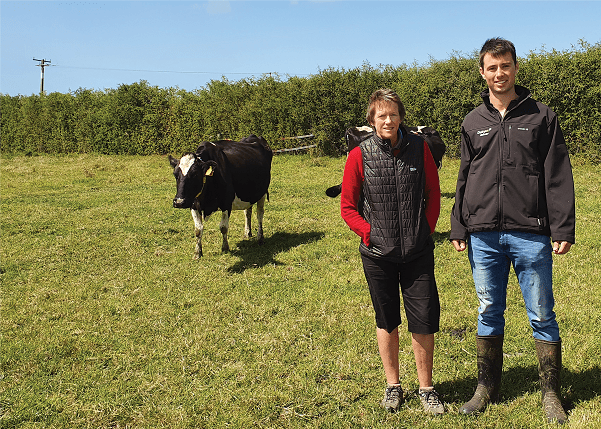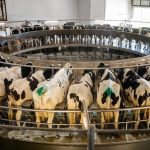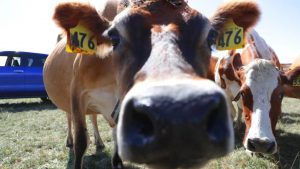
Completing his ag science masters degree through Massey University, with support from the DairyNZ Masters Scholarship, saw Jake Jarman make a retrospective analysis of transitioning to autumn calving, based on data collected from the Dairy Trust Taranaki’s Kavanagh Farm. The 208-hectare research farm, next to Fonterra’s Whareroa dairy factory near Hawera, transitioned to autumn calving between July 2017 and March 2019, with Jake beginning the data analysis in February 2019.
“When I came on board, the experiment had been underway a while and the cows had just finished the extended lactation period and were about to calve the next month.”
“The hard and fast transition process comes with both risks and benefits and that’s what we were looking at,” Jake says.
The benefits of that process include completing the transitioning of the whole herd at the same time and maintaining the herd.
“If you’ve got a connection to the herd, maybe you’ve been breeding it up for years or maybe you just don’t want to sell it, then the extended lactation is a good option. You also get to control that process all the way through.”
The risks include the unsuitability of New Zealand dairy cows for extended lactations which leads to cows gaining above-optimal body condition post 300 days in-milk, which can result in problems around metabolic risks heading into calving.
“Because the cows don’t produce much milk later on in the extended lactation period, there’s going to be a lack of milk production in the second financial year, relative to if the farmer had stayed spring calving,” Jake says.
The data suggests seasonally specific mismatches between feed supply and feed demand. “What we saw over time was through the first winter period when the cows began the extended lactation, a lot of supplementary feed was needed as there wasn’t enough grass available to meet cow feed demand. Conversely, the first summer when they’re just about to be dried off, the cows’ feed demand was really low relative to the pasture supply.
Through the decision rules of the trial, deferred grazing was chosen as an option for the herd. This is believed to have led to an unintended consequence of some cases of ryegrass staggers in the herd just before they started to calve.
‘Because the cows don’t produce much milk later on in the extended lactation period, there’s going to be a lack of milk production in the second financial year, relative to if the farmer had stayed spring calving.’
Swing to autumn calving
There are multiple different reasons to choose autumn calving, including financial, the change in feed demand and the social aspect. The winter milk premium through Fonterra and offered by other supply companies is also an attractive benefit.
“A major driver of this research in South Taranaki is that there is a feeling that summer pasture growth is becoming more variable from year to year and the winter pasture growth rates are increasing.”
“This has driven a lot of farmers in the area to change to autumn or split calving to mitigate the risk of the summer dry and capitalise on greater winter pasture growth.”
Other farmers spoken to referenced a social or personal aspect for the change, with family holidays at the beach during January or February a preference to holidaying in Australia during June or July.
Calving in March and April when the weather is warmer is also appealing and there is anecdotal evidence that the calves respond better and grow quicker.
“We briefly looked at some weather trends in South Taranaki and we saw evidence of an increase in minimum winter air temperatures over the past 30 years, which supports comments from farmers that we’re growing more grass in winter,” comments Jake.
“However we’ve also got to remember we’re putting on a lot more nitrogen and managing the pasture better and growing new pasture species. There’s a combination of factors leading to greater winter pasture growth.”
Show me the profit
The data was recorded over all facets of the farm system, from milk production, supplementary feed, pasture growth, body condition score, reproduction and different economic modelling of the cost, expense, profit and revenue.
“We also looked at different scenarios over a 10-year investment horizon to assess whether changing to autumn calving is a good investment,” Jake says.
Results from the trial concluded a farmer should only consider changing to autumn calving if they can have an economically sustainable system without a winter premium.
he data showed that over 10 years, the autumn calving system was a better investment than spring calving, if the farmer received the winter milk premium – of which there is no guarantee.
“This was also based on the assumption that the autumn-calving farmer produced more milk than the spring-calving farmer, and we only had one year’s data to base that off.”
The trial is continuing at Kavanagh Farm until May 2023 and Jake is keen to retrospectively analyse the data in three years’ time to find out if the autumn calving farmer performs better than the spring calving farmer.
Jake recommends any farmer considering transitioning to autumn-calving talk to a consultant and their bank representative and with local farmers who have already transitioned.
“I think there lots to learn from farmers who have ‘been there and done that’ and it will also help with the region-specific details.”
Jake concludes that autumn calving is highly specific to the unique circumstances of the farm, the region, the climate, the finances of the business and the goals and aspirations of the owners.
“Not every single goal is 100% profit-driven. You’ve got to consider all goals and values, not just profit. You can’t put a price on having a holiday in summer with your family.”























